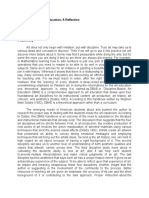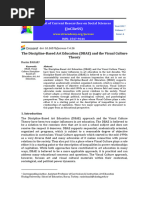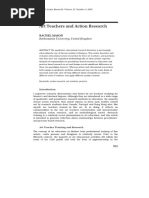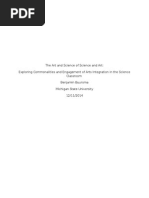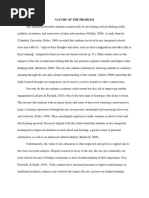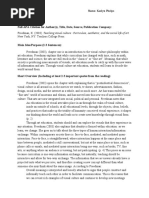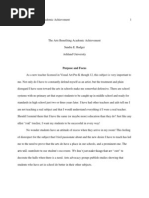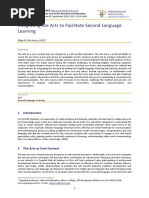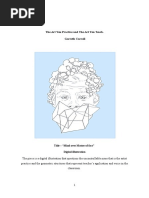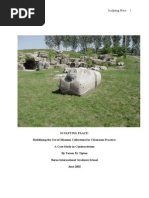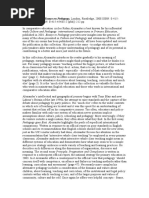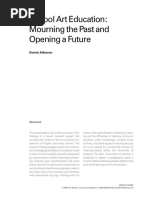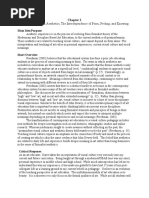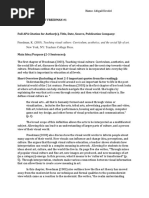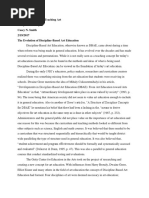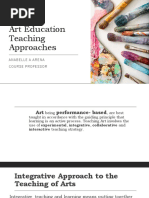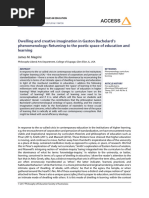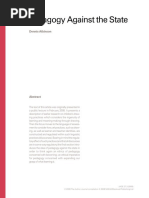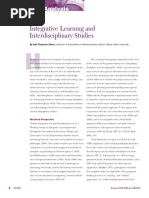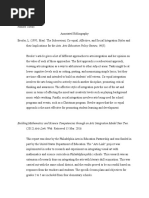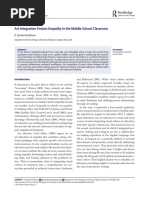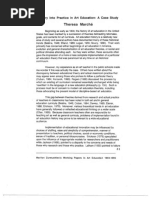JBaxley 797 Synthesis
JBaxley 797 Synthesis
Uploaded by
Joel BaxleyCopyright:
Available Formats
JBaxley 797 Synthesis
JBaxley 797 Synthesis
Uploaded by
Joel BaxleyOriginal Title
Copyright
Available Formats
Share this document
Did you find this document useful?
Is this content inappropriate?
Copyright:
Available Formats
JBaxley 797 Synthesis
JBaxley 797 Synthesis
Uploaded by
Joel BaxleyCopyright:
Available Formats
RUNNING HEAD: VISUAL ART IN AN INTEGRATED CURRICULUM
Visual Art in an Integrated Curriculum
Prepared for EDD 797 By Joel Baxley
VISUAL ART IN AN INTEGRATED CURRICULUM
Views of education and the policies and practices that extend from these views have shifted between two poles akin to those Har Lam & Kember (2004) identified in relation to teachers views of art education. They describe an essentialist view on the one hand, and a contextualist on the other. I will discuss these categories in more detail with regard to art curriculum, but I believe we can apply these terms to the constant shift between progressive views that seek to situate education in the world and look to the broader purposes of students school experiences (contextualist) and back to basics movements that isolate and control content based on narrower disciplinary intentions (essentialist). In this paper, I seek to build an understanding of integrated curriculum on this tense continuum of belief, to establish a case for visual arts place in such a curriculum based on my own views of the nature of visual art in education, and to describe the particular approach to arts integrated instruction employed by the Southeast Center for Education in the Arts.
Definitions Integration Integration refers broadly to the combination of disparate parts into a whole. Beane (1997) identifies four kinds of integration: integration of experiences, the process of bringing new experiences into ourselves and making them a part of our schemes of meaning or the process of applying past experiences to new problems; social integration, the drawing together of disparate knowledge to
VISUAL ART IN AN INTEGRATED CURRICULUM
address relevant social issues; integration of knowledge, the employment of knowledge in context; and integration as a curriculum design, which might better be described as an effort aimed at achieving the first three forms rather than a form unto itself. If we accept that an integrated approach to curriculum design is the way we want to go, we need to decide what we really mean by it. There have been several models of instruction that have used the terms integrated or interdisciplinary. Sometimes, the work is a radial design, with isolated teachers in different subjects simultaneously addressing a common topic, like the elementary rainforest or butterfly units that Erickson (2002) mentions or a study of World War II in which the chorus studies swing music at the same time that the history classes are dealing with the 1940s (Lavine, 2005). For others, what they call integration might only be the employment of activities associated with one discipline used without any real instruction to further another discipline like the assignment of out of class projects where students build a model of the Parthenon or the pyramids using whatever skill and materials they can. Another model, however, consists of in depth studies that focus attention on ideas or problems in such a way that subject matter cannot be taken apart from the whole. I find it difficult to use one term to describe these extremes. It makes the best sense to view integrated curriculum and instruction as a continuum like the one Heidi Hayes Jacobs (1997) describes, which ranges from isolated (or discipline-based) instruction to parallel, multi-disciplinary, interdisciplinary, and finally to a complete integrated program.
VISUAL ART IN AN INTEGRATED CURRICULUM
I do not take the position, as Beane (1990) seems to, that we must have fully integrated work solely around situated projects that focus on student initiated problems. I think we must, as Erickson (2002) does, recognize the need for instruction that flows across that continuum, occasionally in isolated instruction, even accessing memorization in the introductory stages of learning (Efland, 2002). Like all three of these authors, though, I do believe the curriculum as it exists in schools in the United States tends to be a mile wide and an inch deep(Erickson, 2002), and that educators should find ways to move the greater part of our instruction in an integrated direction. Visual Art Aestheticians make the question of What is art? a major component of their discipline, and greatly contrasting views have been proposed at length for centuries. In this case, however, I am not interested in the evaluative question of what good art or bad art might be. I am interested here in describing how the discipline of visual art should be defined for study in schools. We must establish an approach to visual art in education in order to justify or dispute the employment of integrated instruction in its implementation. Har Lam and Kember (2004) found two polar views in the responses of art teachers. They based their descriptors on six aspects of the art teachers approaches: the aim of teaching, the nature of art knowledge, art ability, skill and creativity, conception about process and product, and expected learning outcomes. The essentialist view is identified as basing art education on the essentials of art, that are excluded from other instrumental values (Har Lam& Kember, 2004 p. 292).
VISUAL ART IN AN INTEGRATED CURRICULUM
Such a view aligns, broadly, with a formalist, art for arts sake approach that emphasizes uses of media and the elements of art and principles of design. It is rooted in a modernist view of art that draws a dualist distinction between high and low art (Efland, 2002). Such a dualism narrows the pool of images available for study, and shies away from instruction that might have an instrumental agenda. Strangely, the rote art curriculum and the open ended art curriculum identified by Bresler (1994) might both fit within the essentialist category because of the deemphasis of context or purpose for works of art and the emphasis upon fine art as sources of study. Strictly essentialist approaches are not friendly to the development of integrated curricula. Integration may be seen as a threat to the integrity of the art form. Others approach art with an emphasis not on the art itself, but on what the art is for. In contextualist views, . . . the focus of teaching [is] oriented toward personal development for living in society. (Har Lam & Kember, 2004, p. 294). While elements & principles of design are considered in such study, there is more of an emphasis on content than on form. Where essentialist views may be said to align with a modernist view of art, contextualist views are more aligned with the postmodern. As Marshall (2005) writes, Postmodern theories endorse an art education where art is contextualized, boundaries between domains are blurred, and emphasis is placed on content in relation to form.(p.227) Har Lam & Kembers contextualist view seems to align with a movement in visual art education that proponents call visual culture. Visual culture is critical of what is seen in essentialist or formalist approaches as elitist and unnecessarily
VISUAL ART IN AN INTEGRATED CURRICULUM
restrictive. In this view, a visual art curriculum that insists on strict categories, particularly the accustomed emphasis on formal properties and production misrepresents the realm of knowledge in and through the visual arts as being primarily technical(Freedman, 2003, p. 19). The exclusive focus on fine art as objects for study is torn down, and study is open to include works from popular and material culture. Visual culture education requires teachers and students to wrestle with the ambiguous place of fine art within contemporary culture. A contextualist view is much more open to integration. As Freedman (2003) writes, Challenging the old constructs of knowledge about the visual arts leads to at least some degree of interdisciplinarity. The realm of the visual arts overlaps with other school subjects. Artists draw on all types of knowledge and cognitive processes to create. Therefore, it is less important to think of boundaries in this context than to find ways of addressing the range of content that will help students to understand the visual arts. (p. 19) Extreme views that emphasize form over content or content over form are both flawed. Neither can be understood without the other. Terry Barrett has presented a balanced view. The title of his recent text, Making Art: Form and Meaning (2011) summarizes it nicely. He defines art as the creation of visual artifacts that carry meaning (p.2). This allows the study of works beyond the elitist canon of fine art. However, he also insists on focused attention to the formal properties that constitute the vocabulary and grammar of visual artists. Consider the first two of his principles for interpreting art from his earlier work Interpreting Art: Reflecting, Wondering, and Responding: 1) Artworks are always about something. That is, even
VISUAL ART IN AN INTEGRATED CURRICULUM
the most non-objective, abstract work has some meaning, even if that meaning is not drawn from overt subject matter. And 2) Subject matter+Medium +Form +Content = Meaning (Barrett, 2003). This latter is particularly important. Art is about what we say and how we say it. If then, we adopt an approach toward art education that balances the demands of disciplinary integrity from the essentialist camp and the demand for social and contextual awareness on the other, there are implications for curriculum design. Either isolated, discipline-based art instruction or integrated, issue or idea driven instruction must become both . . . and. Students creating and responding to art must learn to communicate well with as wide a vocabulary as possible, and they must know the grammar associated with each medium that they adopt. They must also pay attention to how their images will be received, how they will appear in context, and what they are responding to or being influenced by.
VISUAL ART IN AN INTEGRATED CURRICULUM
A Mobile Army of Metaphors In The Book of Learning and Forgetting, Frank Smith (1998) argues that the institutional approach to learning exemplified in todays schools is based on a series of over-arching metaphors that have been overlaid on our views of education for the last 150 years. His views align with those of Beane (1997) who wrote The isolation and fragmentation of knowledge is part of the deep structures of schooling. This is evident in the subject-specific curriculum documents, schedules, and other artifacts of middle and high schools and in the separate subject/skill schedule in so many elementary school classrooms(p. 7). According to Smith, the picture of learning prior to its institutionalization was that of a novice being inducted through experience into the world of professional practice. . . . for thousands of years . . . for as long as there has been education (which probably means as long as the human species has existed), there was only one view of learning, and that view was universal. It was, essentially, the classic understanding that you learn from the company you keep. If you want your child to grow up to be a particular kind of person, you put the child in the company of that kind of person. And if you dont want your child to become a particular kind of person, you do everything you can to keep the child out of the company of that kind of person. (p.44) In this approach, the skills we isolate as belonging to this or that discipline would be learned depending on the people with whom one associated.
VISUAL ART IN AN INTEGRATED CURRICULUM
Lakoff & Johnson (1980) say that there are metaphors underlying the way we view our world that go unnoticed, but that have an enormous impact on the ways we perceive and interpret experiences and thus how we will respond to them. They give the example of time as money: we spend it, save it, lose it, etc. This is not an essential characteristic of time itself, but a cultural viewpoint of time that is embedded within our language and thought so deeply that we do not perceive it as metaphorical. An examination of the history of education in the United States reveals a series of overlapping, and sometimes contradictory metaphors that have contributed to contemporary policies. The Barracks In the late nineteenth and early twentieth centuries, one of the sources of inspiration for educational reform movements that formed the structure of public schooling as we know it was the Prussian army, whose successes in the middle of that century formed a model of standardization and meticulous attention to detail that attracted those who sought greater state control over schooling. Prussian methods contributed to the grouping of children by age and ability. The goal in education became like that of the training of Prussian soldiers: the production of identical, standardized trainees (Smith, 1998). The Factory Some metaphors become so overarching that they can be applied to define an era. The late nineteenth century through the end of the twentieth has sometimes been called an Industrial Age, a period dominated by mass production, mass
VISUAL ART IN AN INTEGRATED CURRICULUM 10
consumption, and mass marketing. At the heart of it all lays the factory, the mechanical means of converting the world (seen as raw material) into marketable goods by means of a sequential, machine-based process of assembling standardized parts into standardized wholes. The factory is overseen by a few higher ups that give orders to the line workers whose job is not to think, but simply to add on the next part in the sequence. Factories, as the driving force in the economy, made their presence known in education. Buildings and schedules were constructed with the notion of a cognitive assembly line, moving children from one grade to the next, installing each component in a standardized way in the most time-efficient manner possible (Eisner, 2002; Smith, 1998; Pink, 2008). In this industrial model, the teacher is simply a line worker. Her job is not to think about the curriculum. It is only to deliver it in as timely a manner as possible so that the product can be moved further down the line. Knowledge is broken down into controllable bits for greater efficiency on the assembly line. Content areas become more isolated and compartmentalized. Integration of ideas between content areas is the responsibility of the studentsomething that is simply expected to happen on its own. Beane (1990) points out that in the early part of the twentieth century, social efficiency theorists, who advocated for a linear and piecemeal curriculum, expressed hope that graduates would eventually unify and apply their fragmented school learning through final integration(p. 23). Counterpoint the progressives
VISUAL ART IN AN INTEGRATED CURRICULUM 11
In the 1930s, a counterpoint arose with the progressive education movement. Thinkers like John Dewey, William Kilpatrick, and Thomas Hopkins advocated a curriculum whose end was not a sum of component skills, but a citizen capable of participating in a democracy. That central view encouraged a push toward integrated problem or issue-centered instruction that addressed the concerns and interests of students rather than or in addition to the prescribed content from teachers. The movement showed some promising results in the early 1940s with the Eight Year Study by the Progressive Education Association, which indicated higher levels of college success by students from schools that employed integrated methods. (Beane, 1990) The Laboratory The 1950s saw the death of that progressive movement and the rise of a new metaphor in education: the laboratory. In 1957, the Soviet Union launched Sputnik and the fear and drive for competition that it enflamed in the American public had us scrambling to compete. In times of fear and uncertainty, we grasp for control. At the same time that the progressives were developing their ideas, Behaviorism was born of positivist philosophy. Behaviorists views of shaping and training behavior through objective stimulus-response relationships gained pre-eminence. The hero of education was no longer the captain of industry, it was the man in the white lab coat constructing the maze and managing the bits of cheese. This managing metaphor insisted on an isolation of subjects even stronger than before. After all, in the laboratory, one isolates all the variables from one another for experimental purposes. A curriculum centered on student motivations or social issues would, in a
VISUAL ART IN AN INTEGRATED CURRICULUM 12
strictly behavioral view, be a curriculum centered on the unobservable, therefore on the irrelevant. (Beane, 1990; Smith, 1998; Efland, 2002; Kohn, 1999) The Computer The myths of industry and the laboratory and the barracks were joined over the course of the early decades of the twentieth century by a new metaphor: the computer. Human beings had made thinking machines, and as with the armies, factories, and laboratories they had been fascinated with before, they began to see themselves through this new lens. We began to describe our own brains in terms of the computer. Information processing models for learning and understanding spoke of memory storage, retrieval, the formation of data networks, etc. (Schunk, 2008). This model further reinforced the Cartesian notion that the mind was inside the head and the body was merely a separate tool that was used, like a computers peripheral devices, to access and manipulate information. The dualism of mind and body is inaccurate. The reality is that the senses are not passive means by which the computer receives information, but active members of the thought process (Efland, 2002). Platos Dismissal The cognitive revolution associated most often with Piaget, addressed the limitations of behaviorism, but adopted the body-mind dualism associated with the computer metaphor. For Piaget, for instance, the linear progress of human cognition moved toward logical scientific reasoningabstract modes of thought suited to linguistic and mathematical means of communication. This dualism reinforced a
VISUAL ART IN AN INTEGRATED CURRICULUM 13
marginalization of non-discursive means of meaning making (Efland, 2002; Eisner, 2002). Centuries earlier, Plato had dismissed the arts as lower than rational thought processes. He did this because art was thought to come not from man, but from the Muses. In his view, only logical, rational thought was truly a human accomplishment. That dismissal seems to lie behind the logical-scientific bias that has dominated western education. Benjamin Bloom established three domains called the cognitive, the affective, and the psychomotor . . . the development of these domains in isolation from each other also suggests their conceptual isolation. He may have only done this for organizational purposes, but the division has been accepted, when paired with Piagets developmental theory, as hierarchical (Efland, 2002). This marginalization of the physical and emotional (the separation of the mind from the body) is clearly evident in the demands of contemporary policy. The No Child Left Behind Act gives lip service to the arts as core curriculum, but in fact it only holds schools accountable for math, science, and language arts. The subjects that have been diminished by the draconian requirements of the law are those very things that the Cartesian dualism excludes: P.E., social studies, and the arts (Chapman, 2005). Combined and Conflicted Metaphors A renewal of interest in curriculum integration occurred through the 1990s, but this interest rose concurrent with a discipline-based focus in the standards movement. While authors like Jacobs (1997) and Beane (1997) were arguing for an awareness of the need for contextualized learning, the federal government had
VISUAL ART IN AN INTEGRATED CURRICULUM 14
established first National Educational Goals in 1990 under the George Bush, Sr. administration. That evolved into Goals 2000 under the Clinton administration. These projects led to the creation of recommended national standards for each content area as identified by committees of professionals in each. This included the national standards in the arts (MENC, 1994). Despite the fact that the committees recognized the need for connections to other disciplines, the medium became the message. Each was separate apart from the others. In visual art, the standards movement had been influenced by Gettys Discipline Based Art Education curriculum (Dobbs, 1997). DBAE belongs solidly on the essentialist end of Har Lam & Kembers continuum. It was strictly about visual art, and particularly about fine art. Studies in DBAE tended to center around master works, drawn from the canon of work as identified by the worlds museums. The fear and competitive drive of the fifties re-asserted themselves in the uncertainty of the world under the George W. Bush administration. NCLB reinforced the policy-makers desire for the control of the laboratory and the factory over the products that education yields. The very name of the law suggests a race in which only those who get to the finish line first have really succeeded. The law penalizes schools whose students are not on grade level in reading and math (NCLB, 2001). In other words, if you move too slowly, something is wrong with you, and therefore your school. Good teaching is defined as moving the product along the assembly line at the pace demanded by the generals/bosses/scientists who know better. The practices of the new administration at the federal level have not moved the pendulum from the side of command and control. Rather, they have sought to tie it
VISUAL ART IN AN INTEGRATED CURRICULUM 15
there. The Race to the Top program takes a clearly behaviorist approach to both teachers and students, seeking to provide monetary bits of cheese to the school and teacher rats that successfully accomplish the goals they have set. There is dissension against these regulations, but at the policy level, it does not appear that significant change is forthcoming anytime soon. It will take considerable effort to move toward a learning environment conducive to an integrated approach.
Arts Integration The arts tend to be marginalized, even when there are attempts to create situated, integrated curricula. An excellent example is the recent emphasis on STEM programs (science, technology, engineering, and mathematics). In reaction to this, organizations and artists pushed for the creation of curricula that placed the arts at the core of curriculum reform. The result was the use of the term arts integration. The term has been widely used by different programs and practitioners to mean different things. It is telling that when Gail Burnaford (2007) compiled a literature review for the Arts Education Partnership about arts integration, she found it difficult to find the term clearly defined by even its most vocal proponents. Arts integration may be seen at some levels as an advocacy agenda. Some users of the term are not referring to integrated curriculum in the sense described above, but more in the sense of re-integrating arts disciplines into the school day, where they have been absent. In a political climate that insists on the primacy of math and English content, arts advocates have broadcast instrumental claims about
VISUAL ART IN AN INTEGRATED CURRICULUM 16
the impact of arts instruction on student achievement in non-arts subjects. Documents like Champions of Change (Fiske, 1999) and Critical Links (Deasy, 2002) have been mined for statistics that have appeared on postcards and in ad campaigns. These claims have fallen under serious question from such sources and Winner and Hetland (2007) who showed the flaws in the broad application of much research studies related to instrumental claims, which usually show correlation between arts instruction or experiences and learning in other content, but do not establish causation. Additionally, they and others like Elliot Eisner (2002) have pointed out the danger in tying the place of the arts in the curriculum to their benefit for other content. While these claims may seem to bolster arts programs in the short term in the current political climate, they ultimately sabotage the arts by taking away any attention that might be paid to the value that the arts provide for learners that cannot be found in other parts of the curriculum. If the arts are tied to the rise and fall of test scores in math or science for their existence, then those scores may as easily provide a reason for the removal of arts programs as their inclusion. Some programs emphasize the role of teaching artists in arts integration. They point out the need for expertise in the art form in order to ensure the integrity of instruction in the art form and to prevent the cheapening or misuse of arts content. I have to note, however, that many of the programs that make these claims exist primarily to find work for teaching artists, which draws into question these claims. First, because despite the attempts of reputable organizations like the Kennedy Center and others to establish quasi-certification for teaching artists, there is not any real process to validate the experience and educational skills of the people who hire
VISUAL ART IN AN INTEGRATED CURRICULUM 17
themselves out as teaching artists beyond the usually self-assigned title. Additionally, the assumption that classroom teachers will be unable to provide valid art instruction, particularly at the younger grades, seems weak in light of the fact that we make no such requirement for any other subject in the primary grades. In Teaching Artist-driven programs, the emphasis is more on WHO provides the instruction than on what is taught, how it is taught, or why. A different approach is focused on why content is integrated. Adapting the curriculum design work of Wiggins & McTighe (1998) and Lynn Erickson (2002), the Southeast Center for Education in the Arts (SCEA) crafted a specific definition that sought to balance learning in subjects and learning through them. SCEA had been one of Gettys DBAE dissemination centers. They had undergone serious philosophical shifts with the withdrawal of Getty support and control and the findings of the TETAC project which showed a need for integrated work in the arts. The definition is as follows: Arts integration is instruction combining two or more content areas, wherein the arts constitute one or more of the integrated areas. The integration is based on shared or related concepts, and instruction in each content area has depth and integrity reflected by embedded assessments, standards, and objectives. (cited in Burnaford, 2007, p. 18)
VISUAL ART IN AN INTEGRATED CURRICULUM 18
Why? Why integration? If the aim of public education is solely about the acquisition of a predetermined set of knowledge and skills, then perhaps a more controlling, industrial approach makes sense, but the set of skills todays children need is partially known at best. The facts are important, but the reality is that the facts change (Erickson, 2002). The changes in the global economy have shown that the old expectations for high school graduates are no longer acceptable. The worker of the future cannot be a successful drone, following the accepted patterns of behavior. The environment we live in changes too rapidly. Creative and critical thinking are not merely academic goals; they are now vital skills for the future (Pink, 2008). Behaviorist approaches make no provision for creating new knowledge (Efland, 2002), only for the achievement of expected responses to arranged stimuli. The system of reward and/or punishment advocated by command and control models has actually been shown to diminish innovation (Kohn, 1999). We compare our students to those of the Russians, the Japanese, the Koreans, the Indians, the Chinese, or whoever else scares us at the moment. It is interesting to note, though, that the Chinese, in their push to compete in the global economy have recognized that the old system isnt working. One of the most command and control oriented governments on the planet has ordered that their schools must move toward methods that develop innovation, creativity, and individual thinking in their students (Zhao, 2009).
VISUAL ART IN AN INTEGRATED CURRICULUM 19
If, instead, we think of the aims of education in terms of developing the cognitive capacities of learners (Efland, 2002; Eisner, 2002), then we open ourselves to the need for context in students studies. We strive not only for surface level knowledge of facts, but deeper understanding. To understand a topic or subject is to use knowledge and skill in flexible ways.(Wiggins & McTighe, 1998, p. 24) In the laboratory model, content was removed from context for the benefit of the scientists who studied their methods, not for the benefit of the children. Human learning, however, is always in context. If we learn something in one context, it can be difficult for us to apply it in any other unless we have been given the opportunity to do so. Content given in absence of context creates the likelihood of equation cranking a process of ritualized guessing when students are confronted with new situations (Efland, 2002). Heidi Hayes Jacobs (1997) notes, As children get older, they ask fewer essential questions and more and more managerial or mundane questions. By early adolescence, we hear too many variations on this question from students: Teacher, is this what you want?(p. 28) Integrated instruction should be designed in such a way that students are given the opportunity to address larger issues, questions, or ideas in contexts that approximate as closely as possible the way those issues, questions, and ideas are dealt with in the world outside of school (Erickson, 2002; Lave, 1991). New Metaphors: the City and the Landscape Efland (2002) offers some new metaphors for the curriculum that may replace the assembly line, the barracks, and the laboratory. Those models all demand standardization of product and compartmentalization of content. He suggests the possibility of considering the curriculum as a city, in which zoning laws designate
VISUAL ART IN AN INTEGRATED CURRICULUM 20
the kinds of development allowed in given areas, but which must allow flexibility in the application of those laws to address the needs of the people for whom the laws are made, particularly as needs and populations change. He also considers the idea of a landscape that learners explore. He uses Lynchs work on cognitive maps to frame this picture. Lynch identified five categories in the mental maps we keep of our surroundings: y Paths shared routes of travel y Edges limiting or enclosing structures y Districts larger spaces that have common character y Nodes the points where paths converge, where potential choices in travel may occur y Landmarks distinctive features that people use to orient themselves in space (cited in Efland, 2002, p. 124) This notion of a landscape that we explore, allows for the idea of tracing and retracing our steps, gradually building a more complex, more accurate map as we explore new territory. A landscape or city is not a single, linear pathway. There are better and worse paths, depending on ones destination. Destinations themselves may need to be modified as one comes upon unexpected obstacles or opportunities. There are two dangers in curriculum design that must be avoided. One is the risk of demanding too much control, as mentioned above. The other is the risk of
VISUAL ART IN AN INTEGRATED CURRICULUM 21
providing too little structure (Jacobs, 1997). The idea has been held that creativity is something that must work in a vacuum, that inspiration comes out of the blue and lands upon the creator. This fallacy is particularly applied to the arts. Eisner (2002) refers to it as magical thinking. But human creators do not create from nothing. Whether were speaking of art, science, history, or mathematics, creation is a process of working resourcefully to use the materials available in a new way. It is always an act of building on the experiences at ones disposal and working with and thinking through the materials in ones hands. To take away all structure and you leave the learner wandering in an empty wasteland. There is no answer if there is no question. There is no question if there is nothing to ask about. An explorer in a given curricular landscape will find some places where a single path is followed. At other times, the traveler will come across nodes where paths cross and decisions must be made about the direction of travel. There are times for isolated instruction, times for inter-disciplinary connected work, and times when students should pursue projects in which an observer cannot discern where one content area begins and another ends. The choice about which sort of instruction is needed at a given time for a given group of students is negotiated between the teacher as facilitator of the learning environment (the landscape architect) and the learner. Brookfield (1986) writes that . . . no facilitator enters an educational setting without some (perhaps private) notions as to what constitutes important curricular concerns and desirable purposes. As educators we contribute to (though we can never completely control) the landscape that our students explore. We work to make their experience in the educational landscape
VISUAL ART IN AN INTEGRATED CURRICULUM 22
connect with their journeys outside of school and the destinations that we (and they) desire to reach.
Why Visual Art? As a counter to what they believed were misuses of research data to show instrumental effects of art instruction on other subjects, Eisner (2002) and Hetland, Winner, Veneema, & Sheridan (2006) crafted descriptions of things that the arts provide that either other content does not or does not provide as well. Eisners ten things the arts teach have become a useful advocacy piece for the National Art Education Association, appearing on print and electronic material. The list is a good one: The arts teach children to make good judgments about qualitative relationships. The arts teach children that problems can have more than one solution. The arts celebrate multiple perspectives. The arts teach children that in complex forms of problem solving purposes are seldom fixed, but change with circumstance and opportunity. The arts make vivid the fact that neither words in their literal form nor number exhaust what we can know. The arts teach students that small differences can have large effects. The arts teach students to think through and within a material.
VISUAL ART IN AN INTEGRATED CURRICULUM 23
The arts help children learn to say what cannot be said. The arts enable us to have experience we can have from no other source. The arts position in the school curriculum symbolizes to the young what adults believe is important. Hetland, Winner, Veneema, & Sheridans Studio Thinking (2007) employed qualitative studies of the practices of exemplary visual art teachers at the high school level to identify what students were really learning. They identified eight habits of mind that seemed particularly important in visual arts classes: Develop Craft learning to use and care for tools, materials, etc. Engage and Persist Learning to embrace problems of relevance to world and self and persisting through the completion of art tasks. Envision learning to mentally picture what cannot be observed and imagine possible next steps in making a piece. Express learning to create works that convey an idea, feeling, or personal meaning Observe learning to attend to visual contexts more closely than ordinary looking requires. Reflect learning to think and talk about an aspect of ones work or working process and learning to make judgments about ones own work and process or the work and processes of others. Stretch and Explore learning to reach beyond ones capacities, to explore playfully without a preconceived plan, and to embrace the opportunity to learn from mistakes and accidents.
VISUAL ART IN AN INTEGRATED CURRICULUM 24
Understand the Art World learning art history and current practice, but also learning to interact as an artist with other artists and with the broader society. (Hetland, Winner, Veneema, & Sheridan, 2007) The most powerful of these skills or habits in my mind are those involving slowed down observation and reflection, envisioning or imagining, and playful risktaking. Little of the current curriculum in k-12 schools is geared toward what Perkins (1994) called reflective intelligence. We rush along at break-neck speed through content and do little to take the time necessary to question or play with what we have learned. In the visual art, that slower, focused reflection is vital. Visual art requires us to wrestle with images mentally. We must exercise imagination intentionally and purposefully, not merely as daydreams. Visual art also encourages us to take risks in ways that the high accountability, right answer mentality behind most school content does not. No one asks us to play with mathematical equations (they should, but they usually dont), but in visual art we take play very seriously. Its required for success.
Why integrate visual art with other content? It may seem redundant to ask this question after the previous sections of this document, but I feel the need to address some concerns. In one experience a few years ago, an emotional art educator stood up after a presentation I gave proposing an arts integration program. She challenged our intentions, stating a prevalent fear among arts specialists that integration would be the death of art programs in school
VISUAL ART IN AN INTEGRATED CURRICULUM 25
and, on a more personal level, would lead to the loss of art teachers jobs. I did what I could to assuage her concerns in that moment, but as is often the case I didnt figure out what I really wanted to say to her until it was too late. First, her concerns are about the integrity of the discipline. Her concern is valid. There are plenty of examples on lesson plan databases and in books of work that calls itself arts integration that belongs in what Bresler (1995) called subservient integration. It offers no instruction in the art form at all and focuses all of its real instructional attention on the work in the non-arts content. A stereotypical example would be assigning students to draw a picture of a chosen character from a recently read book. If there has been no attempt to address what is expected of the drawing and no instruction provided for that visual response to literature, then the assignment is decorative at best, and at worst a waste of everyones time. If schools come to expect that as the standard for arts instruction, then we should not claim to teach art. However, if art or any other disciplinary teachers at a school operate in a siloed, self-defensive manner, then we do harm to the learning environment of the school. We must constantly center our attention on the needs of the student. An arts integration program must maintain the integrity of any discipline involved in integrated instruction. But in reality, if by integrity of the discipline we mean holding a students experience of art or music or science or history as close as possible to the operation of that discipline in the world outside school walls, then to teach in self-defensive isolation is actually harmful to the discipline. No artist
VISUAL ART IN AN INTEGRATED CURRICULUM 26
operates without reference to the world outside of art. As Barrett says, all art is about something. Art is a means of communication, and it cannot be taught without reference to what it is talking about. Along these same lines, visual art is a discipline whose boundaries are constantly blurred stretched and pushed by the professionals in the field. Marshall (2009) describes at least five ways that contemporary artists work in an integrative manner, and thus might serve as integrative paths for k-12 learning. She claims that the strategies of depiction, extension/projection, reformatting, mimicry, and metaphormodes through which artists wrestle with ideasshow that learning through the arts is compatible with learning in the arts. (Marshall, 2009, p. 19)
VISUAL ART IN AN INTEGRATED CURRICULUM 27
Thoughts for Current Practice The needs for policy change are beyond the scope of this discussion, but it should be abundantly clear that if the political climate remains as it is, there is little chance for developing integrated curriculum in public schools at large. Some schools have pursued arts integration as a magic wand to solve their difficulties, but I have found that those schools do not tend to fully adopt the philosophical stance toward children and education that would allow integration or arts instruction to flourish. The successes we have begun to see at SCEA have come from schools willing to commit to long term work, riding the waves of frustration and ambiguity that are necessary when trying to accomplish real work with and sometimes in spite of the requirements of policy makers. An approach to visual art that is closely aligned with the world of visual art as it exists in the here and now, not only as it existed in the past, demands an integrated curriculum. It is not sufficient to provide instruction in form and technique. Neither is it sufficient to dwell on content without providing students the visual skills and vocabulary needed to create and respond to meaningful artifacts.
VISUAL ART IN AN INTEGRATED CURRICULUM 28
References
Barrett, T. (2003). Interpreting art: reflecting, wondering, and responding. NY: McGraw-Hill Barrett, T. (2011). Making art: Form and Meaning. NY: McGraw-Hill. Beane, J. (1997). Curriculum integration: Designing the core of democratic education. NY: Teachers College Press. Bresler, L. (1994). Imitative, complementary, and expansive: three roles of visual arts curricula. Studies in art education, 35(2), 90-104. Bresler, L. (1995). The Subservient, co-equal, affective, and social integration styles and their implications for the arts. Arts education policy review, 96(3), 31-37. Brookfield, S.D. (1986). Understanding and facilitating adult learning. San Francisco, CA: Jossey-Bass. Burnaford, G., Brown, S., Doherty, J., & McLaughlin, J. (2007). Arts integration frameworks, research, & practice: A literature review. Washington, D.C.: Arts Education Partnership. Chapman, L.H. (2005). Status of elementary art education: 1997-2004. Studies in art education, 46(2), 118-137. Deasy, R.J. (2002). Critical Links: Learning in the arts and student academic and social development. Washington, D.C.: Arts Education Partnership.
VISUAL ART IN AN INTEGRATED CURRICULUM 29
Dobbs, S.M. (1998). Learning In and Through Art: A Guide to Discipline-Based Art Education. Los Angeles, CA: J. Paul Getty Trust. Efland, A. (2002). Art and cognition: Integrating the visual arts in the curriculum. NY: Teachers College Press. Eisner, E. (2002). The Arts and the Creation of Mind. New Haven, CT: Yale University Press. Erickson, H.L. (2002). Concept-based curriculum and instruction: Teaching beyond the facts. Thousand Oaks, CA: Corwin Press. Fiske, E.B., ed. (1999). Champions of change: The impact of the arts on learning. Washington, D.C.: Arts Education Partnership. Har Lam, B. & Kember, D. (2004). Conceptions of teaching art held by secondary school art teachers. The international journal of art and design education, 23(3), 290-301. Hetland, L., Winner, E., Veenema, S., & Sheridan, K.M. (2007). Studio thinking: the real benefits of visual arts education. NY: Teachers College Press. Jacobs, H.H. (1997). Mapping the big picture: integrating curriculum and assessment k-12. Alexandria, VA: Association for Supervision and Curriculum Development. Kohn, A. (1999). Punished by rewards: The trouble with gold stars, incentive plans, as, praise, and other bribes. NY: Houghton Mifflin.
VISUAL ART IN AN INTEGRATED CURRICULUM 30
Lave, J., & Wenger, E. (1991). Situated learning: legitimate peripheral participation. NY: Cambridge University Press. Lavine Production Group, Inc. (2005). What is arts integration? [Connecting with the arts: a workshop for middle grades teachers.] NY: Annenberg Media. Lakoff, G. and Johnson, M. (1980). Metaphors we live by. Chicago: University of Chicago Press. Marshall, J. (2005). Connecting art, learning, and creativity: A case for curriculum integration. Studies in art education, 46(3), 227-241. Marshall, J. (2009). Five ways to integrate: Using strategies from contemporary art. Art education, 63(3), 13-19. No Child Left Behind Act (NCLB) (2001). Public Law 107-110. Perkins, D. (1994). The Intelligent Eye: Learning to Think by Looking at Art. Santa Monica, CA: The J. Paul Getty Trust. Pink, D. (2008). A whole new mind: Why right-brainers will rule the future. NY: Riverhead Books. Schunk, D.H. (2008). Learning theories: An educational perspective. 5th edition. Upper Saddle River, NJ: Pearson. Wiggins, G., & McTighe, J. (1998). Understanding by design. Alexandria, VA: Association for Supervision and Curriculum Development.
VISUAL ART IN AN INTEGRATED CURRICULUM 31
Zhao, Y. (2009). Catching up or leading the way: American education in the age of globalization. Alexandria, VA: ASCD
You might also like
- M. Parsons Art and Integrated Curriculum-1Document22 pagesM. Parsons Art and Integrated Curriculum-1Tache RalucaNo ratings yet
- MODULE 1: DidacticsDocument9 pagesMODULE 1: Didacticszakaria zagour100% (4)
- Philosophy of Arts EducationDocument7 pagesPhilosophy of Arts Educationjane barquin100% (1)
- Arts ImmersionDocument4 pagesArts ImmersionDylan ThomasNo ratings yet
- Discipline-Based Art EducationDocument5 pagesDiscipline-Based Art EducationBryan Luci100% (2)
- 03-A Basak 2017 DBAE & Visual CultureDocument12 pages03-A Basak 2017 DBAE & Visual CultureCatalina MancillaNo ratings yet
- Art Teachers and Action ResearchDocument18 pagesArt Teachers and Action ResearchCatarina MartinsNo ratings yet
- Arts Integration FinalDocument8 pagesArts Integration Finalapi-519224747No ratings yet
- Buursmate808 Finalactionresearchproposal 12 10 2014Document31 pagesBuursmate808 Finalactionresearchproposal 12 10 2014api-291226705No ratings yet
- Literature Synthesis Revised FinalDocument10 pagesLiterature Synthesis Revised Finalapi-461550357No ratings yet
- Connecting Art, Learning, and CreativityDocument16 pagesConnecting Art, Learning, and CreativitychnnnnaNo ratings yet
- Phelps 18facilitationDocument13 pagesPhelps 18facilitationKaelyn PhelpsNo ratings yet
- Arts IntegrationDocument6 pagesArts Integrationapi-623772170No ratings yet
- The Artist-Teacher: Models of Experiential Learning: G. James DaichendtDocument19 pagesThe Artist-Teacher: Models of Experiential Learning: G. James DaichendtMauricio Ríos100% (1)
- Original Paper: Broadening The Understanding of Art EducationDocument7 pagesOriginal Paper: Broadening The Understanding of Art Educationz45bks4cwsNo ratings yet
- Chapter Three Pedagogies in Higher EducationDocument15 pagesChapter Three Pedagogies in Higher EducationNurhalimah FebriantiNo ratings yet
- Journal of Art For LifeDocument18 pagesJournal of Art For LifeSopyan AhmadNo ratings yet
- BEED33 Chapter1 Lesson3Document5 pagesBEED33 Chapter1 Lesson3AARON MUNDANo ratings yet
- Literature Review:: Strategies For Teaching Art To Grade 1& 2Document9 pagesLiterature Review:: Strategies For Teaching Art To Grade 1& 2alia haiderNo ratings yet
- Alter Paper PDFDocument14 pagesAlter Paper PDFMilaziNo ratings yet
- An Analytical Exploration of The Pedagogical Philosophy in Collaborative Painting Under The Framework of DBAE TheoryDocument17 pagesAn Analytical Exploration of The Pedagogical Philosophy in Collaborative Painting Under The Framework of DBAE Theoryvinnie128128No ratings yet
- Freire Aesthetic Through RanciereDocument16 pagesFreire Aesthetic Through RanciereErick FloresNo ratings yet
- Arp3 BadgerDocument12 pagesArp3 Badgerapi-112174453No ratings yet
- Academic Writing - ArtDocument8 pagesAcademic Writing - ArtClay Jan Dela CruzNo ratings yet
- Integrating The Arts To Facilitate Second Language Learning: Olga N. de Jesus, Ed.DDocument4 pagesIntegrating The Arts To Facilitate Second Language Learning: Olga N. de Jesus, Ed.DHamizon Che HarunNo ratings yet
- The Art You Practice and The Art You Teach - Final 5Document6 pagesThe Art You Practice and The Art You Teach - Final 5api-318503482No ratings yet
- Sculpting TimeDocument24 pagesSculpting TimeDr. Teresa M. Tipton100% (1)
- Literature Review of Intentional Teaching Pedagogy in The ArtsDocument31 pagesLiterature Review of Intentional Teaching Pedagogy in The ArtsStefanie LorimerNo ratings yet
- Robin Alexander ReviewDocument3 pagesRobin Alexander ReviewAnastasia CristianaNo ratings yet
- Standard 3Document5 pagesStandard 3api-406139711No ratings yet
- School Art Education-Mourning The Past and Opening As The FutureDocument13 pagesSchool Art Education-Mourning The Past and Opening As The FutureZé de RochaNo ratings yet
- The Anthropology of Didactics-2018-05-23t09 54 17.896ZDocument12 pagesThe Anthropology of Didactics-2018-05-23t09 54 17.896ZJuanJoséGualteroNo ratings yet
- Facilitation Laurahulseberg Freedman AllpagesDocument10 pagesFacilitation Laurahulseberg Freedman Allpagesapi-336819762No ratings yet
- Orzolek, 2018Document7 pagesOrzolek, 2018dancostinescu1963No ratings yet
- Webster, P. Construction of Music Learning. MENC Handbook of Research On Music Learning.Document92 pagesWebster, P. Construction of Music Learning. MENC Handbook of Research On Music Learning.goni56509No ratings yet
- A Narrative Tale: Ats-Intergrated Inquiry For Mentoring Teachers For Social Justice by Friend, Waddell, Poos, Caruthers, DeGraffDocument37 pagesA Narrative Tale: Ats-Intergrated Inquiry For Mentoring Teachers For Social Justice by Friend, Waddell, Poos, Caruthers, DeGraffAnonymous UzUdEwc8E0No ratings yet
- Van Baalen Et Al. - 2021 - Higher Education, The Arts, and TransdisciplinaritDocument22 pagesVan Baalen Et Al. - 2021 - Higher Education, The Arts, and TransdisciplinaritAraceli MartínezNo ratings yet
- Artistic and Creative Literacy G-3Document62 pagesArtistic and Creative Literacy G-3민수학100% (3)
- Chapter 1 Introduction - Art CriticismDocument51 pagesChapter 1 Introduction - Art CriticismRohazlina HassimNo ratings yet
- Freedman Facilitations Total Abigail KrodelDocument17 pagesFreedman Facilitations Total Abigail Krodelapi-534724490No ratings yet
- Integrated CurriculumDocument20 pagesIntegrated CurriculumalhanunNo ratings yet
- Edci301 Nichols PersonalstateDocument6 pagesEdci301 Nichols Personalstateapi-253458327No ratings yet
- Art and Aesthetic EducationDocument8 pagesArt and Aesthetic EducationMasoomeh HaghighiNo ratings yet
- Fusion Integration Inter and Intra CourseDocument3 pagesFusion Integration Inter and Intra CourseHira Matloob100% (1)
- Casey Smith Independent ProjectDocument9 pagesCasey Smith Independent Projectapi-334262626No ratings yet
- Approaches To Teaching LiteratureDocument9 pagesApproaches To Teaching LiteratureFrosa DolorosaNo ratings yet
- Ej 1059521Document9 pagesEj 1059521Ging Ging Llanos JavierNo ratings yet
- Lesson 6 Art Education Teaching ApproachesDocument18 pagesLesson 6 Art Education Teaching ApproachesmonsNo ratings yet
- 2003 Curriculum IntegrationDocument15 pages2003 Curriculum IntegrationMary Grace Peralta ParagasNo ratings yet
- RR054 NoyesDocument8 pagesRR054 NoyesAdamNo ratings yet
- Accessav38n1 066Document18 pagesAccessav38n1 066moobinamalNo ratings yet
- Pedagogy Against The StateDocument16 pagesPedagogy Against The StateZé de RochaNo ratings yet
- Perez, Joey Module 1Document7 pagesPerez, Joey Module 1Joey PerezNo ratings yet
- Visual Arts and Academic AchievementDocument43 pagesVisual Arts and Academic AchievementLouis SpencerNo ratings yet
- Integrative Learning and InterdisciplinaDocument3 pagesIntegrative Learning and InterdisciplinabekirNo ratings yet
- Building Mathematics and Science Competencies Through An Arts Integration Model Year TwoDocument7 pagesBuilding Mathematics and Science Competencies Through An Arts Integration Model Year Twoapi-284107666No ratings yet
- Art Integration Fosters Empathy in The Middle School Classroom.Document10 pagesArt Integration Fosters Empathy in The Middle School Classroom.Eric GomezNo ratings yet
- Theory Into Practice in Art Education - A Case StudyDocument11 pagesTheory Into Practice in Art Education - A Case StudyVirág KissNo ratings yet
- Artspedsenscapstone 1Document12 pagesArtspedsenscapstone 1api-390879517No ratings yet




